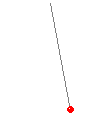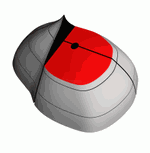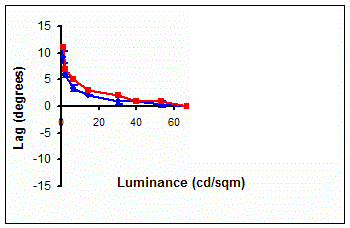Index
The Pulfrich Phenomenon:Monocular Counterparts
Contents
 The classical Pulfrich phenomen refers to a peculiar distortion of binocular vision that involves dynamic dysmetropia in depth. The phenomenon is easily elicited by means of a pendulum that is made to swing in the observer's frontal plane. When a light-attenuating filter is put in front of one eye, the pendulum will appear to swing in and out of the plane, following a more or less ellipsoidal trajectory. The phenomenon may also arise spontaneously with some acquired disorders of vision. The Pulfrich phenomenon is not limited to pendulum views: all kinds of moving target views will be affected in similar fashions. The Pulfrich phenomenon has been covered in more detail elsewhere on this site.
The classical Pulfrich phenomen refers to a peculiar distortion of binocular vision that involves dynamic dysmetropia in depth. The phenomenon is easily elicited by means of a pendulum that is made to swing in the observer's frontal plane. When a light-attenuating filter is put in front of one eye, the pendulum will appear to swing in and out of the plane, following a more or less ellipsoidal trajectory. The phenomenon may also arise spontaneously with some acquired disorders of vision. The Pulfrich phenomenon is not limited to pendulum views: all kinds of moving target views will be affected in similar fashions. The Pulfrich phenomenon has been covered in more detail elsewhere on this site.
The classical Pulfrich phenomenon has attracted much attention for close to a century but little if any notice has been given to the possible existence of monocular counterparts. Yet there are good reasons to assume that such animals do exist. The reasoning is as follows. The binocular Pulfrich phenomenon is attributed to dissimilar rates of neural conduction in the two eyes, which sets the scene for perceived disparity in depth. It is reasonable to expect that dissimilar rates of neural conduction also can take place within different parts of the retina in one and the same eye. Localized dissimilarities cannot set the scene for disparity in depth. Instead, an image moving over the retina is likely to evidence a lag of movement of those parts of the image that fall within the affected retinal areas. Hence, instead of the three-dimensional, dynamic illusion of depth that occurs in the binocular situation, there should arise a two-dimensional, dynamic illusion of lag, or deformation, or both
[1].
Demonstration of retinal lagging
Demonstration of a monocular Pulfrich counterpart requires (1) an optical image that moves over the retina and (2) means of localized dimming of this image. Localized dimming cannot easily be produced by light-attenuating filters. A better approach is to present a test target that contains different luminances. This can easily be done in computer graphics, which also allows the use of nulling to estimate magnitudes of lag. Below is an example of a display implementing these ideas. Normal observers need not cover one eye: with normal vision, the display looks the same under monocular and binocular conditions.
Lazy Shadow Display © L. Frisén 2006
Click the Start button to make the light and dark bars rotate around the display center. Now try to decide whether or not the two bars remain exactly parallel. Most likely, they will seem to form an angle, as if the dim bar lags behind the bright bar. The lag can be compensated by repeatedly clicking the left and right mouse buttons inside the display. Once parallelism has been obtained, it is instructive to stop rotation, to see how large the required lead angle is. The direction of rotation can be changed by right-clicking the Start button. Try different light and speed settings to see how they affect the magnitude of lag (incidentally, Internet Explorer is quite insensitive to changes of speed settings).
 The diagram to the right presents some quantitative results. The vertical axis shows observed lag angles. Rate of rotation increases from left to right and contrast increases with increasing depth. Each bar represents the average of three
measurements in a normal subject. The full report was the Editor's Choice for the November 2007 issue of the British Journal of Ophthalmology [1].
The diagram to the right presents some quantitative results. The vertical axis shows observed lag angles. Rate of rotation increases from left to right and contrast increases with increasing depth. Each bar represents the average of three
measurements in a normal subject. The full report was the Editor's Choice for the November 2007 issue of the British Journal of Ophthalmology [1].
Loosely speaking, the dimmer, outer shape can be called a shadow of the brighter shape. Because the shadow lags behind, I have named the phenomenon the Lazy Shadow. Another implementation of the Lazy Shadow phenomenon can be viewed at Michael Bach's
gold mine of illusions.
Are there acquired counterparts?
Can the monocular Lazy Shadow illusion arise spontaneously, precisely like the classical, binocular Pulfrich phenomenon? The prospects seem quite good. The primary requirement is the spontaneous presence of local variations in apparent brightness across the retinal image. Such variations should occur within most kinds of relative, localized visual field defects. Obviously, absolute defects are disqualified as there is no vision within such defects. Likewise, uniform depressions are disqualified: there must be local variation. Given local variation, the possibility exists that neural transmission may be locally delayed. What is required to unmask any local delays of transmission is a uniform movement of the retinal image.
 Consider, for example, a mid-chiasmal syndrome, with temporal hemifield depressions and normal nasal hemifields. Conceivably, a lagging percept within a temporal hemifield might be unmasked by sliding a horizontal, bar-shaped test target along the vertical meridian. The "temporal" part of the bar should then appear to lag behind the "nasal" part, as if the bar had a vertical offset in the middle. The test would have to be done monocularly, of course. However, the offset effect would presumably be quite small and easily obscured by extraneous factors like variations in target speed and fixation stability.
Consider, for example, a mid-chiasmal syndrome, with temporal hemifield depressions and normal nasal hemifields. Conceivably, a lagging percept within a temporal hemifield might be unmasked by sliding a horizontal, bar-shaped test target along the vertical meridian. The "temporal" part of the bar should then appear to lag behind the "nasal" part, as if the bar had a vertical offset in the middle. The test would have to be done monocularly, of course. However, the offset effect would presumably be quite small and easily obscured by extraneous factors like variations in target speed and fixation stability.
For a credible demonstration of an acquired Lazy Shadow illusion, a more formal approach is required. It should include a nulling feature. A display like the one
 presented above might prove useful, although the test task would need to be changed. Instead of trying for alignment of the dim and bright bars, the observer should watch the center of the bright bar and signal any apparent changes of its shape. Conceivably, whenever one half of the rotating bar enters the depressed temporal hemifield, it should appear to be darker and to lag behind the bar in the nasal hemifield, as if the whole bar was slightly bent in the middle. Further, the whole bar should appear to stutter slightly when crossing the vertical meridian. These effects should be nullable by introducing an adjustable lead angle within the temporal hemifield. A fully adjustable Java applet demonstration can be viewed in a separate window (enabled Java JRE plug-in required).
presented above might prove useful, although the test task would need to be changed. Instead of trying for alignment of the dim and bright bars, the observer should watch the center of the bright bar and signal any apparent changes of its shape. Conceivably, whenever one half of the rotating bar enters the depressed temporal hemifield, it should appear to be darker and to lag behind the bar in the nasal hemifield, as if the whole bar was slightly bent in the middle. Further, the whole bar should appear to stutter slightly when crossing the vertical meridian. These effects should be nullable by introducing an adjustable lead angle within the temporal hemifield. A fully adjustable Java applet demonstration can be viewed in a separate window (enabled Java JRE plug-in required).
Clinical implications
The above discussion used the simple example of a hemifield depression but the reasoning about localized delays of neural transmission should be applicable to most types of relative, localized visual field defects. A clinical corollary, that is, a perception of a spontaneous, dynamic, two-dimensional dysmetropia, also requires movement of the retinal image. Movement of natural retinal images occurs more or less continuously in daily life, for example, during pursuit eye movements, and when moving through the environment. Hence, there is certainly a potential for a frequent occurrence of spontaneous Lazy Shadow phenomena.
Prediction of the nature of acquired Lazy Shadows is fairly easy for localized field defects with simple shapes and uniform depths. However, defects with complex shapes and non-uniform depths, for example, arcuate scotomata, are presumably associated with quite complex varieties of Lazy Shadows. Actually, the conceivable complexities of Lazy Shadow phenomena within localized, relative visual field defects boggle the mind, and particularly so when considering the frequent co-existence of bilateral and asymmetric visual field defects. These complexities make it unlikely that patients might provide spontaneous, verbal descriptions. Nevertheless, knowledge of Lazy Shadow phenomena should prove helpful when attempting to understand the grand picture of life with abnormal vision.
As mentioned above,
an acquired, binocular Pulfrich phenomenon may be compensated by putting a light-attenuating filter in front of the quicker eye. Unfortunately, there seems to be no comparable remedy for monocular Lazy Shadows.
Finally, a curio note. Carl Pulfrich had suffered a unilateral eye injury and was effectively monocular. Hence, he was unable to see the phenomenon that carries his name. However, Dr Pulfrich should have been able to see the monocular counterpart described here, nearly 100 years later.
The Lazy Shadow may race ahead!
 The results presented above showed that the lag angle of the dimmer, outer shape decreased monotonically with decreasing contrast, approaching zero at a luminance level approximating one-half of the luminance of the brighter, inner square, as exemplified in the diagram to the right. With this kind of behavior there seemed to be little point in trying higher outer square luminances in the original study
[1].
However, extended measurements using rotating squares have shown that this was an unfortunate decision. Indeed, these new measurements have revealed a completely unexpected phenomenon, namely, that the dimmer square will race ahead at higher luminances (slide the cursor over the diagram to uncover the results from the higher luminance range).
The results presented above showed that the lag angle of the dimmer, outer shape decreased monotonically with decreasing contrast, approaching zero at a luminance level approximating one-half of the luminance of the brighter, inner square, as exemplified in the diagram to the right. With this kind of behavior there seemed to be little point in trying higher outer square luminances in the original study
[1].
However, extended measurements using rotating squares have shown that this was an unfortunate decision. Indeed, these new measurements have revealed a completely unexpected phenomenon, namely, that the dimmer square will race ahead at higher luminances (slide the cursor over the diagram to uncover the results from the higher luminance range).
The diagram shows lag angles as a function of outer square luminance, for two normal subjects. The inner square luminance was kept constant at 140 cd/m². Each datum point represents the average of three measurements; for clarity, standard deviations are shown for one subject only. Rate of rotation, 39 RPM; subtended visual angles, 4.3° for the inner square and 5.9° for the outer one. Data collected in October, 2007.
While the original results remain compatible with the contention that neural signals from dimly illuminated areas of the retina may be delayed relative to those from more brightly illuminated areas, the new results obviously must have another type of explanation. Presently, none can be offered. These new observations indicate that clinical corollaries of disturbed neural transmission may be truly baffling.
Top
End
 The classical Pulfrich phenomen refers to a peculiar distortion of binocular vision that involves dynamic dysmetropia in depth. The phenomenon is easily elicited by means of a pendulum that is made to swing in the observer's frontal plane. When a light-attenuating filter is put in front of one eye, the pendulum will appear to swing in and out of the plane, following a more or less ellipsoidal trajectory. The phenomenon may also arise spontaneously with some acquired disorders of vision. The Pulfrich phenomenon is not limited to pendulum views: all kinds of moving target views will be affected in similar fashions. The Pulfrich phenomenon has been covered in more detail elsewhere on this site.
The classical Pulfrich phenomen refers to a peculiar distortion of binocular vision that involves dynamic dysmetropia in depth. The phenomenon is easily elicited by means of a pendulum that is made to swing in the observer's frontal plane. When a light-attenuating filter is put in front of one eye, the pendulum will appear to swing in and out of the plane, following a more or less ellipsoidal trajectory. The phenomenon may also arise spontaneously with some acquired disorders of vision. The Pulfrich phenomenon is not limited to pendulum views: all kinds of moving target views will be affected in similar fashions. The Pulfrich phenomenon has been covered in more detail elsewhere on this site.
 The diagram to the right presents some quantitative results. The vertical axis shows observed lag angles. Rate of rotation increases from left to right and contrast increases with increasing depth. Each bar represents the average of three
measurements in a normal subject. The full report was the Editor's Choice for the November 2007 issue of the British Journal of Ophthalmology [
The diagram to the right presents some quantitative results. The vertical axis shows observed lag angles. Rate of rotation increases from left to right and contrast increases with increasing depth. Each bar represents the average of three
measurements in a normal subject. The full report was the Editor's Choice for the November 2007 issue of the British Journal of Ophthalmology [ Consider, for example, a mid-chiasmal syndrome, with temporal hemifield depressions and normal nasal hemifields. Conceivably, a lagging percept within a temporal hemifield might be unmasked by sliding a horizontal, bar-shaped test target along the vertical meridian. The "temporal" part of the bar should then appear to lag behind the "nasal" part, as if the bar had a vertical offset in the middle. The test would have to be done monocularly, of course. However, the offset effect would presumably be quite small and easily obscured by extraneous factors like variations in target speed and fixation stability.
Consider, for example, a mid-chiasmal syndrome, with temporal hemifield depressions and normal nasal hemifields. Conceivably, a lagging percept within a temporal hemifield might be unmasked by sliding a horizontal, bar-shaped test target along the vertical meridian. The "temporal" part of the bar should then appear to lag behind the "nasal" part, as if the bar had a vertical offset in the middle. The test would have to be done monocularly, of course. However, the offset effect would presumably be quite small and easily obscured by extraneous factors like variations in target speed and fixation stability.
 presented above might prove useful, although the test task would need to be changed. Instead of trying for alignment of the dim and bright bars, the observer should watch the center of the bright bar and signal any apparent changes of its shape. Conceivably, whenever one half of the rotating bar enters the depressed temporal hemifield, it should appear to be darker and to lag behind the bar in the nasal hemifield, as if the whole bar was slightly bent in the middle. Further, the whole bar should appear to stutter slightly when crossing the vertical meridian. These effects should be nullable by introducing an adjustable lead angle within the temporal hemifield. A fully adjustable Java applet demonstration can be viewed in a separate
presented above might prove useful, although the test task would need to be changed. Instead of trying for alignment of the dim and bright bars, the observer should watch the center of the bright bar and signal any apparent changes of its shape. Conceivably, whenever one half of the rotating bar enters the depressed temporal hemifield, it should appear to be darker and to lag behind the bar in the nasal hemifield, as if the whole bar was slightly bent in the middle. Further, the whole bar should appear to stutter slightly when crossing the vertical meridian. These effects should be nullable by introducing an adjustable lead angle within the temporal hemifield. A fully adjustable Java applet demonstration can be viewed in a separate  The results presented above showed that the lag angle of the dimmer, outer shape decreased monotonically with decreasing contrast, approaching zero at a luminance level approximating one-half of the luminance of the brighter, inner square, as exemplified in the diagram to the right. With this kind of behavior there seemed to be little point in trying higher outer square luminances in the original study
[
The results presented above showed that the lag angle of the dimmer, outer shape decreased monotonically with decreasing contrast, approaching zero at a luminance level approximating one-half of the luminance of the brighter, inner square, as exemplified in the diagram to the right. With this kind of behavior there seemed to be little point in trying higher outer square luminances in the original study
[